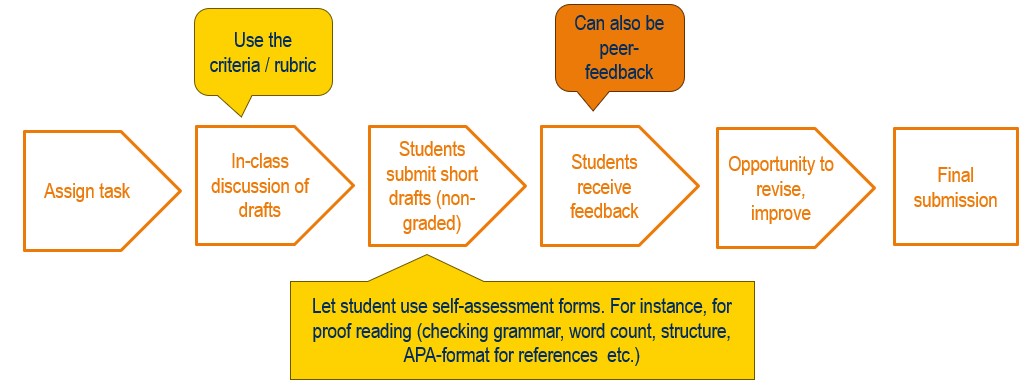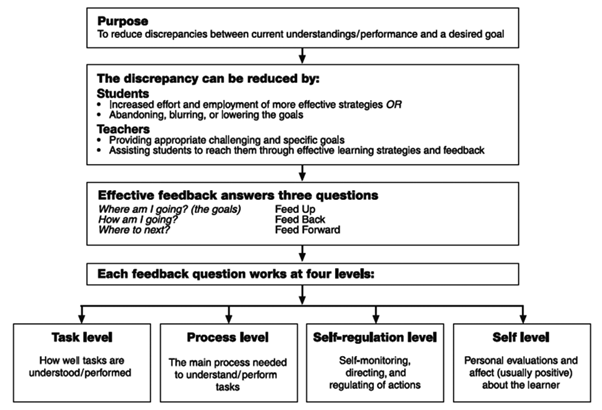Toolbox
Organize the assignment process and the (intermediate) feedback
Organizing aspects
A well-thought-out assignment process, including (intermediate) feedback opportunities, will enhance student learning and contribute to student success.
Students can refine their work incrementally when feedback is incorporated into the process. A key issue here, however, is how to shape this process efficiently and effectively. Points to consider are among others:
- How much time will be needed? For one large assignment or some smaller assignments? Will there be a build-up approach of interim products?
- Will students work on tasks and assignments during lectures and tutorials (in class) or out of class (at home or on Campus)? Or both?
- Will it be an individual assignment or group assignment, or a combination?
- Expectation management is key. How to communicate clearly what is expected? The requirements, purpose, objectives, criteria, etc.?
- How will all the activities be structured? Or is this up to the students? Will there be deadlines for (interim) deliverables and milestones, which will help the students to plan their activities accordingly? Can the efforts be divided realistically over the available period?
- How can the assignments (content-wise, process-wise) be designed to engage and motivate the students?
- How can interim feedback be incorporated? Efficiently? who will provide the feedback?
- Who will be involved? Teachers? Tutors? Teaching Assistants? Others, such as stakeholders or commissioners?
The image shows an example of how the assignment process can be organized for an elaborate assignment. The example is based on an example from Queen's University and relates to a written piece of work, but can be easily adapted to other kinds of products. By making use of in-class feedback and peer feedback, the process can be set up efficiently.

Interesting sources with tips:
> Help students plan with a visually appealing overview - VU Amsterdam. How to help students plan their work.
> Assignments in active blended learning - VU Amsterdam - Also for not blended use. Look under: Active learning activities and assignments.
Feedback with impact
John Hattie investigated in a meta-literature-study which teaching activities most impact student learning. Feedback was one of the activities with the highest effect rates on student learning and achievement. Nevertheless, not all feedback is effective, and feedback is not effective all the time. If concepts are not understood well, it might be more effective to provide extra instruction than to provide feedback. Feedback should be timely, specific, clear, meaningful, actionable and aligned with the learning goals and criteria, but there are more considerations. An important condition for feedback with impact is that students can act upon it. If students don't act upon the feedback, it will be ineffective. Ideally, feedback should be a tool for development; encouraging self-reflection, growth, and stimulating motivation and ability to work towards better (academic) results.
John Hattie and Helen Timperley conceptualize feedback as “information provided by an agent (e.g., teacher, peer, book, parent, self, experience) regarding aspects of one’s performance or understanding.” Feedback (based on Sadler, 1989) needs to provide information specifically relating to the task or process of learning. It fills a gap between what is already understood and what is aimed to be understood. Feedback is not so much about telling students what they did right/wrong, but the intention is to foster deeper understanding and improvement.
Model of feedback
Hattie & Timperley constructed a Model of feedback. In the following video, this model is nicely and briefly (3.26 min.) explained: The Power of Feedback.

Essential in the model is that the feedback process focuses on 3 questions for the students:
- Where am I going? (feed up)
Essence: Ensuring that students understand the learning objectives and the expectations related to an assignment or task. Expectation management is a key issue. This might for instance mean discussing the requirements and criteria with the students. - How am I going? (feedback)
Essence: Indicating for the students how well they progress towards the goals and expected outcomes. In general, this means evaluating the work or performance of the students in relation to the requirements and criteria. - Where to next? (feed forward)
Essence: Guiding the students on the next step for improvement of a product or enhancing the learning process. In practice, this means often that advice is provided and opportunities are offered for further improvement or learning.
Hattie and Timperley mention four levels of feedback:
- Task Level: Focused on the task (e.g., correctness, clarity).
Example: "The cookies you made are too dark and seem burned.”
Most useful when the student has completed an activity or assignment and needs guidance to understand whether, to what extent, and why the outcome or solution was correct or the performance was successful. Less useful when students are still in the process of learning a concept or struggling with solving a problem. - Process Level: Focused on the approach, process, or strategy, the student uses and guiding this. It focuses on the ‘how’ of learning.
Example: "How often did you check what was happening in the oven, after you put in the cookies?”
Most useful when the student is learning to use strategies, methods, or steps needed to accomplish a task and needs to (learn to) improve their approach to solving problems or performing tasks. Less useful when the student has already mastered the strategy or process and most importantly wants to know if the result is valid. - Self-regulation Level. Focused on guiding students to monitor and adjust learning and work strategies, to manage emotions, to reflect on a process and their progress. The feedback can prompt self-reflection, with questions such as “What might you try differently next time?”
Feedback on the self-regulation level has to do with fostering awareness and responsibility; and stimulating self-directed learning.
Example: "Think about how you can adjust your activities next time so you can build in quality checks for each step during the process, to ensure good quality cookies in the end."
Most useful when students are in the process of becoming more self-directed and reflective in their learning. Less useful if students are still struggling with basic tasks or processes and aren’t able or used to reflect on and regulate their own learning or working process. - Self-level. Students receive feedback about the self as a person. This kind of feedback contains no or little task-related information and is seen as having too little value to result in learning gains. It might be friendly or encouraging, but it is in general not very effective.
Example: "Your efforts were great!”
Fostering self-regulation is seen as the most impactful way to support students in their (academic) development. As stated by Hattie & Timperley: “Effective learners create internal feedback and cognitive routines while they are engaged in academic tasks. [….] Less effective learners have minimal self-regulation strategies, and they depend much more on external factors (such as the teacher or the task) for feedback. They rarely seek or incorporate feedback in ways that will enhance their future learning or self-regulation strategies.”
Nevertheless, it will depend on the task at hand and what is and can be expected of students at a certain moment in the learning process, which kind of feedback is optimal.
Who can provide feedback
Feedback on deliverables can come from various sources. It can be provided for formative and/or summative purposes. A combination of feedback sources can also be deployed.
Who | Formative | Summative | Other / Explanation |
Course teacher(s) / examiner(s) | X | X | The designated examiner is responsible for the grading |
Teaching Assistants (TAs) | X | X | Summative under the supervision and responsibility of the examiner |
Peers | X |
| Not often used summatively; mostly as constructive feedback. |
Group-members | X | (X–limited) | Can be on products and process. |
Self | X |
| Critical reflection, usually with the help of instruments (questions, checklist, rubric, etc.) |
External reviewers | X | (X-advise) | Constructive feedback from industry, professional,l or other perspectives. Judgment can be considered in a grade |
Stakeholders, commissioner | X | (X-advise) | E.g. in project-based learning or CBL, internships, and thesis projects. |
Simulation programs | X | (X-mostly limited) | How students go through the program may contribute to or determine the grade |
Automated feedback (e.g. quizzes, small tasks) | X | (X-limited) | Canvas or online tools or specialized software can provide automated feedback on certain types of assignments (such as multiple-choice quizzes, and programming assignments). This may yield bonus points. |
Artificial Intelligence | X |
| Can be initiated and generated by the teacher and/or students. |
Guidebooks | X |
| Guidebooks can offer questions and assignments with solutions. |
Interesting sources with tips:
> Ideas and tips for peer feedback
> Ideas and tips for self-assessment
> Tips for Active Blended Learning - Vrije Universiteit Amsterdam / see under Peer feedback (Tip 11: How to get students to provide and process peer feedback
better // Tip 13: How to get students to provide and process peer feedback better // Tip 28: Constructive feedback? Ten tips! // Tip 37: Do’s and don’ts for effective peer feedback // Tip 38: Do’s and don’ts for effective peer feedback)
Tips for effective and efficient feedback
Providing students feedback is very important in this process, it helps them understand their strengths and areas for improvement, but when it comes to guiding students and assessing, it takes a lot of time and effort from the teaching staff. All the more important to look for ways to ensure that the provided feedback has an impact and at the same time to look for ways to provide the feedback efficiently.
In the two checklists (combined) below we provide ideas and tips for both. But every teaching situation will differ. Browse the list and see what you already apply successfully and what might be useful ideas in your situation for the future.
On the last page, we provide some more sources with ideas and tips. Checklist - Providing feedback with impact and efficiently

